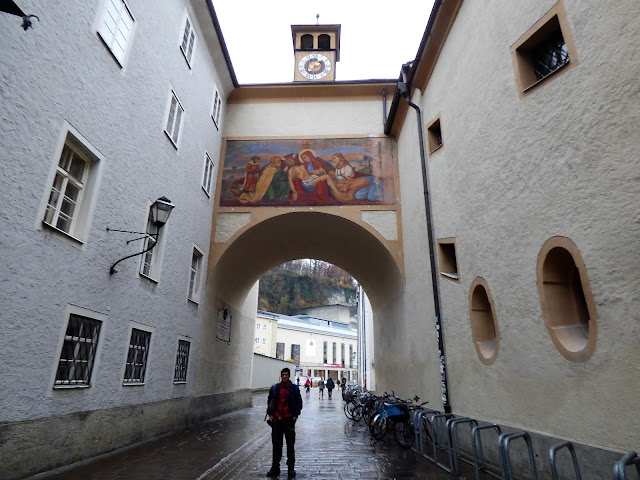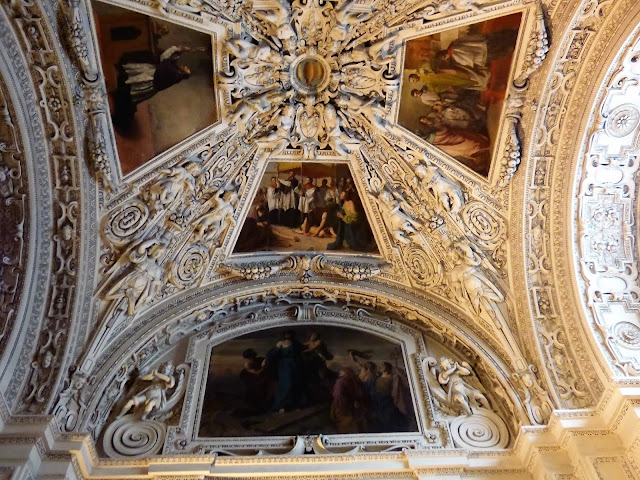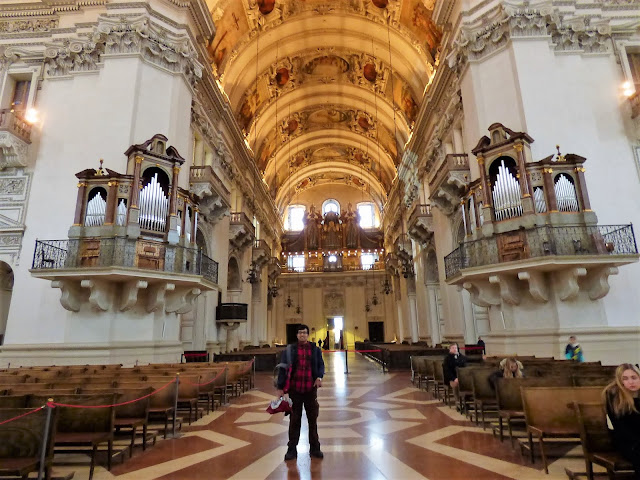DAY 5, November 21, 2017
TRAIN TO SALZBURG:
We
had called for a taxi at 5.15 am at our Prague hotel and reached the station
by 5.30.
We waited for the platform number to be posted, went over
and got into the train which was already there.
We took the early
morning train at 6.05am from Prague to Salzburg. We had bought
discounted online ticket from the official Czech railway site and
printed the tickets at home.
The train terminated at Linz and we had
a connection in 20 minutes. It should have been easy but our train
started off from Prague 10 minutes late. They kept announcing the
delay was because the train arrived late from abroad! Anyways we had
less than 10 minutes at Linz, no time to seek out the electronic
boards for our train platform number. A girl going the same route was
saying the platform is 6, we just scurried there and yes, it was
right.
We got into the train that was coming from Vienna airport and
going onward to Germany. We monitored and got down at Salzburg hbf.
A&O Salzburg Hauptbahnhof:
We
stayed 2 nights at A&O Salzburg Hauptbahnhof. It's
350 m from the train station. Room is spacious, clean, the common
kitchen can be used for cooking.
We had an early check in as soon as
we landed. There is SPAR supermarket right at the station. All in all
a very good experience.
TRANSPORT CARD:
We
bought the 24 hour card for 3,80 euros from the machine, validated
with the time stamp on 1st use. Buses 1, 3, 5, 6 all go to
town center. We took one and got down at Rathaus. We walked toward
the Fortress/Festung
Hohensalzburg.
Here's the transport map from the site, with relevant places circled
Here's the transport map from the site, with relevant places circled
Old Town:
This
picturesque city occupies both banks of the River Salzach,
which here emerges from the Salzburg Alps into an expanse of
lower land dominated by the 1,853-meter Untersberg .
The
romantic Old Town is an area of narrow medieval streets
With
500 years of independent rule by Prince-Archbishops, a medieval
Salzburg grew quite wealthy and full of graceful Baroque
architecture. Salzburg’s city center was lucky enough to
retain its beautiful architecture by avoiding The 30 Years War and by suffering
relatively minor damage during WW2.
Salzburg’s Old Town still holds much of its original charm, the hills are very much still alive with The Sound of Music (The real Maria lived here and the movie was also shot here!).
Salzburg’s Old Town still holds much of its original charm, the hills are very much still alive with The Sound of Music (The real Maria lived here and the movie was also shot here!).
It's
also the birthplace of Wolfgang Amadeus Mozart,
We
reached Domplatz and entered the cathedral.
Dom zu Salzburg (Salzburg Cathedral):
A prominent building thanks to its twin 79-meter towers, Salzburg Cathedral (Salzburger Dom) was completed in 1657 and is famous for its Italian style and its role as the location of Mozart's baptism.
The building's west front, facing the Domplatz, has four colossal marble statues, the outer ones representing Saint Rupert holding a salt barrel, and Virgil with a church both, patron saints of the province, while the inner ones depict Saint Peter with keys, and Saint Paul holding a sword. Statues of apostles as well as Moses and Elijah are further up the facade.
Notable features include its three massive bronze doors with their symbols of Faith, Love, and Hope; the high altar with its Resurrection painted in 1628; and the superb frescoes in the vaulting.
Salzburg
Cathedral (Dom) is by far the biggest church in Old Town, faces
3 town squares at once, and is where Mozart was baptized. The
original Christian parish on the grounds was completed by Saint
Virgil (Bishop from 767-84) and was about half the size of the
current Cathedral.
The cornerstone for this Cathedral was laid in 1614 (opened 1628).
It is a miracle that the new Salzburg Cathedral was built at all as most of Austria got swept up in Europe’s Catholic versus Protestant 30 Years’ War during the construction. Salzburg was able to rely on its rich salt production to have enough money to build this massive Church while most other cities had to scale back on their building projects.
It is a miracle that the new Salzburg Cathedral was built at all as most of Austria got swept up in Europe’s Catholic versus Protestant 30 Years’ War during the construction. Salzburg was able to rely on its rich salt production to have enough money to build this massive Church while most other cities had to scale back on their building projects.
Inside
the entrance is the bronze baptismal font (1311) with lion
statues (1200) where Mozart was baptized.
The
most impressive part of the interior is the huge 233 foot tall
dome which is painted into two eight piece sections depicting
scenes from the Old Testament to go with murals of Passion of
the Christ along the nave.
During
WWII a bomb crashed right through the dome, but luckily didn’t
explode.
The church still has the working organ from 1703 that
Mozart played during two years as the Church’s organist,


We walked toward the funicular Festungbahn


We walked toward the funicular Festungbahn
Fortress can be sighted here
We reached the Kapitelplatz, again with a great view of the fortress.
Kapitelplatz:
Two contemporary things here are the giant over-sized chess board, and a 30-foot-tall yellow orb
sculpture (Mozartkugel/ Mozart ball)with a man on top called Sphaera.
Sphaera was
made in 2007 by artist Stephan Balkenhol and is locally called Mann
auf Mozartkugel. Balkenhol is well known for using this same
male figure in a series of statues throughout Europe (Mann on
Giraffe, Mann on Stump, Mann on Elk). Munich Germany’s city center has the same
male figure from this Salzburg sculpture walking off a steel beam in
another of the Balkenhol’s works.
Mozartkugel is a famous confection made of pistachio marzipan, and nougat, covered with dark chocolate created in 1890
Mozartkugel is a famous confection made of pistachio marzipan, and nougat, covered with dark chocolate created in 1890
Continuing through Kapitelplatz Square, is a medieval Horse Bath Fountain (Kapitelschwemme) from 1732 AD which is framed by two lovely trees. It's under renovation now.
Nowadays the Kapitelschwemme is more of a well and pond, but back in the 1700s it was used by the Prince-Archbishop to bathe horses. The sloping ramp at its entrance would allow the horses to easily enter the water and proceed all the way up to the Neptune fountain.
Sound of Music movie fans will recognize the Horse Bath as where Maria and the kids danced around while singing ‘My Favorite Things’. The square has excellent views of the High Fortress on the hilltop above.
We reached the funicular station and bought 12 euro tickets which include entry to the fortress. The funicular is the oldest in Austria. It has transported visitors up to the castle since 1892 but in those days it was powered by water. Fortress is accessible by a pleasant 20-minute walk from the Old Town center or via this funicular railway from Festungsgasse, riding up to the castle every ten minutes.
Fortress/Festung Hohensalzburg:
Salzburg
is dominated by the picturesque fortress of Hohensalzburg, on the
southeastern summit of the Mönchsberg.
The original castle was built in 1077, with much of what's seen today dating from the early 1500s.
Puppet museum:
This is a lovely puppet museum

Nice models of the fortress and how the funicular was built...
There are lovely antique furniture
The Royal apartment is GREAT; there is a separate small entry fee
AWESOME view from the windows...
We had planned to walk down to Stift Nonnberg (Maria's Abbey) but it had become dark and we wound up for the day
VIDEO LINK:
Our video of Salzburg, Fuschl am see is here:
Our report of the day trip to the lovely Salzkammergut (lake region) and covering the rest of Salzburg old town with some Sound of Music sites is here:
























































































No comments:
Post a Comment